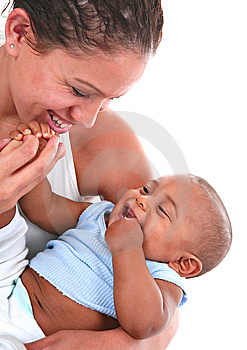culture's role in facial expression
Even if our facial expressions are a result of physiological processes, they are still really only meaningful when they are made in the presence of other people. Doesn't this necessarily mean that culture plays a huge role in facial displays?
There are many problems with claiming the universality of facial expression. Facial expressions are necessarily culture-bound. It is obvious to us that we make certain faces because of our interactions with other people. Certain faces are acceptable in certain situations, and others are not. Additionally, it seems that, at least some of the time, we smile because other people smile or frown because other people frown. Some research has reflected this logical idea that culture helps people learn when and where to make certain facial expressions.

The observations of infants made by Messinger, Fogel, and Dickson suggest that culture plays a vital role in the development of one's ability to express themselves facially. Their observations of the smiles made by babies suggest that social context is imperative as babies begin to smile and to learn what a smile means: "Half of infant Duchenne smiling at 3 months was accompanied by maternal Duchenne smiling. Mothers tended to match infant Duchenne smiles with smiles of their own. It is likely that infants become aware of this pattern and that at some point they also begin to match their mothers' Duchenne smiles" (Messinger). Some experts would go as far as to say that facial displays do not have any meaning at all unless they are contextualized (Fridlund). Even Paul Ekman, in his stringent Facial Expression Program, admits that different cultures have different display rules regarding when and where it is appropriate to make certain faces (although he also asserts the the "true" face "leaks" through) (Russell).
As time has progressed and as theories about facial expression have been scrutinized, it seems that most researchers take a more moderate approach to the matter. They usually meet somewhere in the middle, saying that there are certain patterns of facial movement that occur in all people, but this does not mean that every single aspect of producing and interpreting facial expressions is the same in every culture (Russell).
Eibl-Eibesfeldt nicely summarizes how humans and animals can display certain traits as a result of the way they have evolved genetically but also as a result of their environment: "Phylogenetic adaptation is supplemented by adaptation via learning and individual experience, and, in humans, also via traditions" (Eibl-Eibesfeldt 16). He argues that if certain customs survive the test of time, then these are customs that have been "selected" to help our species, just as certain genes live on in a population because they are helpful to a certain species. Thus, although facial expressions certainly have some sort of biological aspect to them, they could also be an example of something that has been selected by a type of "cultural evolution".
Although he found that deaf and blind children make faces that are similar to those made by people who are able to see and hear, Eibl-Eibesfeldt admitted that they were "certainly less refined than those of sighted children" (31). So, facial expressions can serve as an example of a characteristic of humans that is a result of phylogeny and of cultural evolution. They are certainly, at least in part, "innate" qualities that a human would display even if he or she is unable to learn them from those around him or her. But, the capacity to make facial expressions is fully developed as a result of the influence that an individual's social interactions have.
As time has progressed and as theories about facial expression have been scrutinized, it seems that most researchers take a more moderate approach to the matter. They usually meet somewhere in the middle, saying that there are certain patterns of facial movement that occur in all people, but this does not mean that every single aspect of producing and interpreting facial expressions is the same in every culture (Russell).
Eibl-Eibesfeldt nicely summarizes how humans and animals can display certain traits as a result of the way they have evolved genetically but also as a result of their environment: "Phylogenetic adaptation is supplemented by adaptation via learning and individual experience, and, in humans, also via traditions" (Eibl-Eibesfeldt 16). He argues that if certain customs survive the test of time, then these are customs that have been "selected" to help our species, just as certain genes live on in a population because they are helpful to a certain species. Thus, although facial expressions certainly have some sort of biological aspect to them, they could also be an example of something that has been selected by a type of "cultural evolution".
Although he found that deaf and blind children make faces that are similar to those made by people who are able to see and hear, Eibl-Eibesfeldt admitted that they were "certainly less refined than those of sighted children" (31). So, facial expressions can serve as an example of a characteristic of humans that is a result of phylogeny and of cultural evolution. They are certainly, at least in part, "innate" qualities that a human would display even if he or she is unable to learn them from those around him or her. But, the capacity to make facial expressions is fully developed as a result of the influence that an individual's social interactions have.
How does culture play a role in the way we analyze and the way we think about facial expression?
For one thing, it is extremely difficult to try to talk about the interpretation of facial expressions between different cultures, because different languages might not use words to describe the same types of feelings. The way that Ekman claims there to be about seven distinct emotions (happiness, sadness, surprise, fear, anger, contempt, and disgust) seems very ethnocentric. It is extremely difficult (some might say impossible) to try to find a direct correspondence to each of these seven "emotions" in every different language around the world. Therefore, when conducting cross-cultural research about how different people would classify different facial displays (as Ekman does, p 207), it is very difficult to get good data. Linguist and anthropologist Anna Wierzbicka, puts it plainly when she says, "The point is that, as empirical cross-linguistic studies show, there are simply no emotional expressions interpreted the same way across cultures" (Wierzbicka).
Not only would one's language influence the way that he or she thinks about or talks about facial expression, but a person's individual background and experiences would also be a cause for diversity in interpretations of facial expression. James Russell organized a study in 1994 that suggested that illiterate people were less able to correlate emotions with the facial expressions that they were supposed to represent than literate people were. These findings seem to suggest that one's culture and one's individual place in that culture does have a major influence in the way a person is taught how to identify facial expressions in others (Russell).
Not only would one's language influence the way that he or she thinks about or talks about facial expression, but a person's individual background and experiences would also be a cause for diversity in interpretations of facial expression. James Russell organized a study in 1994 that suggested that illiterate people were less able to correlate emotions with the facial expressions that they were supposed to represent than literate people were. These findings seem to suggest that one's culture and one's individual place in that culture does have a major influence in the way a person is taught how to identify facial expressions in others (Russell).
These four world leaders come from very different backgrounds, but they all use their faces in similar ways to indicate that they are pleased with regard to their current situation. However, if they attempted to discuss the specifics of what their facial displays actually mean to each individual, it might prove to be more difficult to come to a consensus than it is for them to come to a political consensus.

